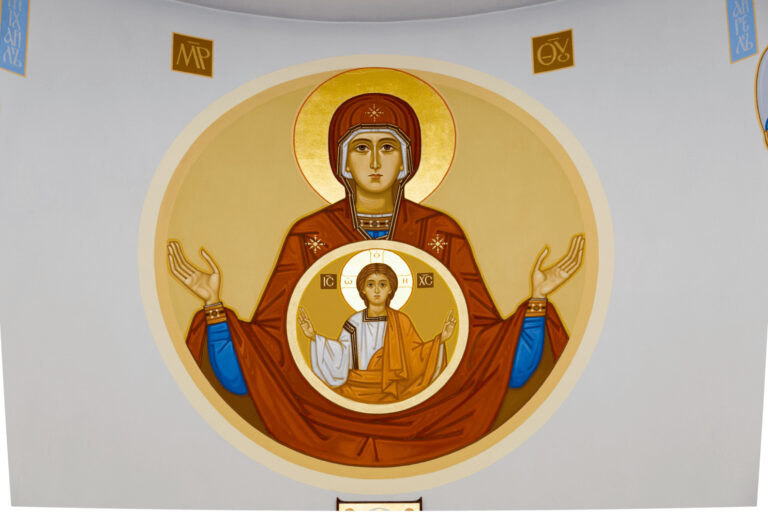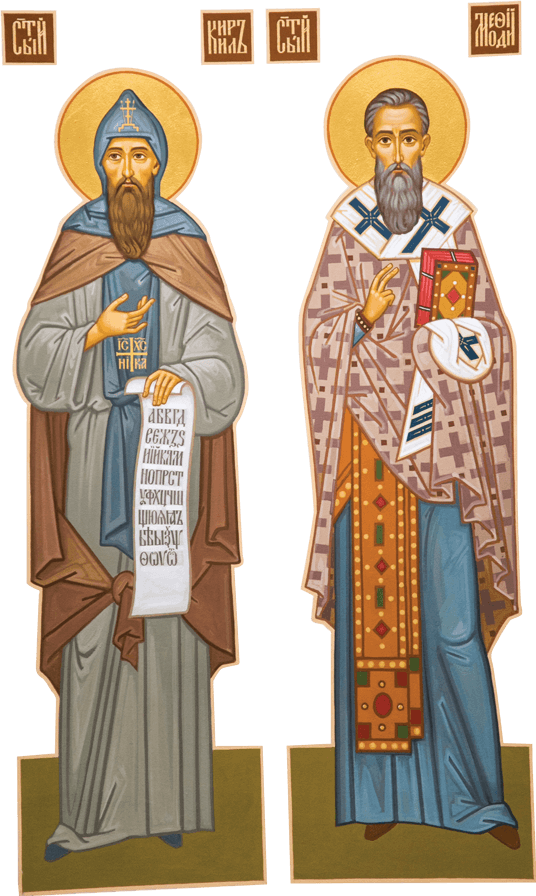The Church
The Eastern Catholic Church sacrificed to the Divine Wisdom has been located in Košice, municipality Dargovských hrdinov since 2003. The church architecture represents an effort for unification of the historical components typical for the churches of the Christian east with modern features. This has created the continuity between the eastern Christianity antiquity and its topicality nowadays.
The church layout comprises the Greek, i.e. equal angle cross, in compliance with the ancient rules. Above the cross, there is one main and four smaller onion-shaped domes in compliance with the Byzantine tradition, all of them ended with a three-leg cross. Together with the cross, the church height reaches 19.5 m. The church is of conical shape.
We can discover a double meaning in this architectonic component. Looking upwards, human attention is focused on the Jesus Christ while looking from inside through the Pantocrator icon located in the middle of ceiling, or from outside through the Jesus Christ cross. Another component can be perceived through the widening conical shape coming out of the cross. This indicates mercy or strength of the cross that is given to and embracing all.
In the line with many wooden churches in the Eastern Slovakia, the church interior is divided in the sanctuary, aisle and antechapel. Total built-up area of the church refers to 298 m2 with diameter of approx. 18 m. In this way the church is mainly of a chamber nature where a priest and the faithful people can better enjoy the community and fellowship. It is a single storey object with chorus and without basement.

Sanctuary
The church sanctuary or an altar (altar area) as it used to be called in the eastern Churches, is situated in the oval part of the church, called apse. This is to indicate the difference from the secular world, being a symbol of the heaven. Concurrently, two facts point to this fact: Solea – elevated stair that separates the prothesis from the aisle, and iconostasis (the wall of icons). Since the prothesis is a sacred place, only clergy is allowed to enter this area.
Altar, also called a pre-table (throne) represents a central component of the sanctuary. On the right side, there is a table of ovation or prothesis serving to preparation of offerings (bread and wine). On the left side, there is a deacon table serving to placement of liturgical objects..
Behind in the sanctuary, there is a row of chairs, so called upper stool indicating the education service provided by the Church. Therefore, only bishop is allowed to sit on the main throne that was entrusted with the announcement duty..

Prestol / Throne
The altar of the table of offerings is called a prestol in the Eastern Orthodox Church, i.e. the first or foremost table. Along with the place of offerings, it symbolizes the divine Throne of God along with the place of offerings, and the Jesus Christ presence thereon as our Lord of All..
The throne represents the Sepulcher of Christ since the holy body of Jesus Christ is placed thereon. Following the eastern churches example, the throne in the Church of Divine Wisdom is of rectangular shape and made of wood. Rectangularity symbolizes four points of compass – the north, the west, the south and the east, and the sacrifice is made on the throne for them. It also represents an invitation for all corners of the world to participate on the sacrifice.
The fact that the throne is made of wood indicates the temporary nature of the world. Since the throne is the most blessed component in the Church, only priest is allowed to touch it and only during the Holy Mass serving.
Icons in the church
The Christian east doesn´t understand the icons as an artwork only but also as a window to the heaven. Because of its symbolic, the icons invite the humans to enter the God´s atmosphere and its mercy.
Accordingly, the icons are called the Bible for the illiterate in the east. This was the reason why the author of icons doesn´t paint them but writes them and the icons are read or interpreted. The Church of Divine Wisdom contains plenty of these treasures of the east.
The icon of cross
The icon of three-leg cross written on the wood is located above the upper table in the Sanctuary. This icon is an illustration of the crucified Jesus Christ behind the town fortifications, as the event is interpreted in the evangels.
The Most Holy Mother of God and Apostle John are below the cross. Under the cross base, there is a skull picture illustrating the Adam´s grave. According to the eastern tradition, the cross was built in the area of the first human being buried.
Along with Mandilion, the Jesus Christ face imprint, the Sun and the Moon is illustrated on the top of the cross. They point to the love of the God that descended from the eternal heaven into the human time and space. The Christian east doesn´t make illustrations of the crucified suffering and tortured Christ but as Jesus Christ Lord. Being crucified, Jesus Christ also beat death.
Therefore the Jesus Christ body isn´t wounded and covered with blood, nor does he hang on the cross but stands with the hands open towards the whole world.


Oranta
The “Oranta,” or the “Great Panagia,” which depicts the Blessed Mother with her arms extended upward, is popularly known as the “Immovable Wall” or the “Indestructible Wall.” Fundamental iconographical types of the Most Holy Mother are as follows: Umilenije (the loving mother), Odigitria (the mother as companion during journeys), and Oranta (the praying mother)..
The last named one is located in the Church also in the rear of the Sanctuary. On the painting there is the Holy Mother with the praying hands raised above.
Mercy coming from her prayers isn´t her mercy but mercy of Jesus Christ who she accepted in her life and still bearing in her heart.
Therefore the blessing Jesus Christ is displayed in the middle. The icon is also named as the Wider than the Heaven („Širšaja Nebes“) since the Holy Mother hands are open and ready to embrace the humans, inviting them to the community with her Son.
Christ Pantocrator
The term Pantocrator means the Lord of All or the Mightiest. Jesus Christ as the Lord of the whole world is illustrated under this name also in the iconography.
According to words of the Apostle Paul, to believe that Jesus Christ is a lord means to discover the truth that opens the heaven to us. Therefore the Pantocrator´s icon is located in the center of the church dome and it can be seen when you raise your eyes towards the heaven.
Golden background of the icon indicates the strength and glory of the Lord of All. Jesus Christ as a lord is not punishing, it is not a tyrant but the one who wants to give everybody what he or she deserves – which means participation on the divine life. Therefore Jesus Christ blesses with one hand in order to deliver his mercy to the all and holds the Evangel open in his left hand that teaches people how to get closer to Jesus Christ.
Jesus Christ look directed to everybody invites the all to redemption or “zbožestvenie”, as it is called in the eastern Christianity.

St. Basil the Great
St. Basil the Great (330 – 379 AD) is illustrated in the altar area on the left side. He was born in Cesarea, Capadoccia, where he later performed as a bishop.
He belongs to four Church fathers of the Christian east. He is an author of numerous theological papers, he compiled the rules for monastic lifestyle and he is allegedly an author of one of the eastern liturgy texts bearing his name.

St. John the Chrysostom
St. John Chrysostom (344 – 407 AD) is another famous Church father in the east whose painting is situated on the right side of the Sanctuary.
The title „Chrysostom“ was given to him thanks to his eloquent sermon in which he, as a Constantinople bishop (current Istanbul) often criticized social disparities and injustice, or costly lifestyle of the Church corps.
Accordingly, he fell into disgrace of the governing circles and had been exiled for a few times. He had merit in the most frequently used text of the Eastern Liturgy.
St. Cyril and Method equal to holy apostles
According to a few historians the eastern type mass served in our territory is a direct heritage of the Slavic apostles and brothers from Thessaloniki, St. Constantine Cyril (827 – 869 AD) and Method (815 – 885 AD).
Their icons decorate the right wall of the front church aisle.
According to the tradition, St. Constantine Cyril is displayed on the icon wearing the monk´s habit and Method wears the bishop´s habit.


Blessed P. P. Gojdič and blessed V. Hopko
The icons of two Eastern Orthodox bishops and martyrs are situated opposite to the Slavic apostles – on the left side of the church aisle.
Blessed Pavol Peter Gojdič, OSBM (1888 – 1960), resident bishop, and blessed V. Hopko (1904 – 1976) auxiliary bishop, both from Prešov, died of martyrium since they refused to recall their affiliation to the Holy See and change for Russian Orthodox Church preferred at the time by the communist regime.
